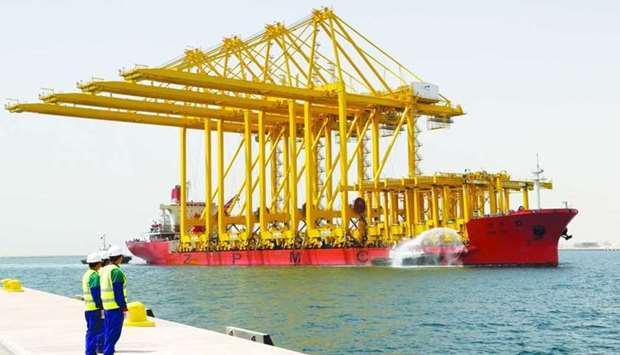Hamad Port has handled container volume of more than 5mn TEUs or twenty foot equivalent units since the start of operations.
"This milestone reflects positively on the growth of the port, which is steadily making its way to becoming one of the most efficient and competitive ports in the region," said QTerminals, a terminal operating company jointly established by Mwani Qatar (51% shareholding) and Milaha (49% shareholding).
The Hamad Port's second container terminal (CT2), which began operations recently, has" robust" technological infrastructure supporting the sector.
HE Prime Minister and Interior Minister Sheikh Khalid bin Khalifa bin Abdulaziz al-Thani had in December 2020 inaugurated the initial operations of the CT2, which is poised to enhance the country’s competitiveness.
The 403,500 sqm CT2 development project comprises four phases. Full operation of Phases 1 and 2 will start before the end of 2022; while Phases 3 and 4 will be developed later to raise the port’s operational capacity according to local market’s needs.
The equipment used at the CT2 is environmentally friendly and low in carbon emissions, said Mwani Qatar, which is a pivotal entity responsible for managing the nation’s seaports and shipping terminals.
The government's plan is to transform Qatar into a vibrant regional trading hub in the region, given its geographical proximity with the continents and attractive regulatory, legal environment as well as robust infrastructure.
Sources in the port and logistics sectors said the Hamad Port's large potential has attracted the world's leading shipping lines.
Qatar’s major trade partners include China, the US, Europe, and Japan. The world’s largest shipping lines and other mainline operators now call directly at Hamad Port, and many are expanding their existing routes. New routes include services from China/the Far East and Bangladesh, and established routes that have expanded include the Far East, India/Pakistan, Oman, and Europe/the Mediterranean.
In 2019 Mwani Qatar and Swiss-based Mediterranean Shipping Company (MSC) had entered into a pact that will see Hamad Port become a regional hub for the Swiss company’s trans-shipment business.
The agreement will help in attracting more trans-shipment containers and encourage more international shipping lines to add Hamad Port to their regional routes and sign similar agreements in the future.
The multi-billion dollar investment in the ports sector not only offers expanded capacities, but also brings a host of new, sector-specific capabilities in the maritime sector.
As a vital support to the infrastructure preparations for the 2022 FIFA world cup and several world events and projects, Mwani Qatar, under the guidance of the Ministry of Transport and Communications, works closely with stakeholders and partners to increase cargo volumes both inbound and outbound and establish its entities preferred ports of call for all shipping lines.
"This milestone reflects positively on the growth of the port, which is steadily making its way to becoming one of the most efficient and competitive ports in the region," said QTerminals, a terminal operating company jointly established by Mwani Qatar (51% shareholding) and Milaha (49% shareholding).
The Hamad Port's second container terminal (CT2), which began operations recently, has" robust" technological infrastructure supporting the sector.
HE Prime Minister and Interior Minister Sheikh Khalid bin Khalifa bin Abdulaziz al-Thani had in December 2020 inaugurated the initial operations of the CT2, which is poised to enhance the country’s competitiveness.
The 403,500 sqm CT2 development project comprises four phases. Full operation of Phases 1 and 2 will start before the end of 2022; while Phases 3 and 4 will be developed later to raise the port’s operational capacity according to local market’s needs.
The equipment used at the CT2 is environmentally friendly and low in carbon emissions, said Mwani Qatar, which is a pivotal entity responsible for managing the nation’s seaports and shipping terminals.
The government's plan is to transform Qatar into a vibrant regional trading hub in the region, given its geographical proximity with the continents and attractive regulatory, legal environment as well as robust infrastructure.
Sources in the port and logistics sectors said the Hamad Port's large potential has attracted the world's leading shipping lines.
Qatar’s major trade partners include China, the US, Europe, and Japan. The world’s largest shipping lines and other mainline operators now call directly at Hamad Port, and many are expanding their existing routes. New routes include services from China/the Far East and Bangladesh, and established routes that have expanded include the Far East, India/Pakistan, Oman, and Europe/the Mediterranean.
In 2019 Mwani Qatar and Swiss-based Mediterranean Shipping Company (MSC) had entered into a pact that will see Hamad Port become a regional hub for the Swiss company’s trans-shipment business.
The agreement will help in attracting more trans-shipment containers and encourage more international shipping lines to add Hamad Port to their regional routes and sign similar agreements in the future.
The multi-billion dollar investment in the ports sector not only offers expanded capacities, but also brings a host of new, sector-specific capabilities in the maritime sector.
As a vital support to the infrastructure preparations for the 2022 FIFA world cup and several world events and projects, Mwani Qatar, under the guidance of the Ministry of Transport and Communications, works closely with stakeholders and partners to increase cargo volumes both inbound and outbound and establish its entities preferred ports of call for all shipping lines.


